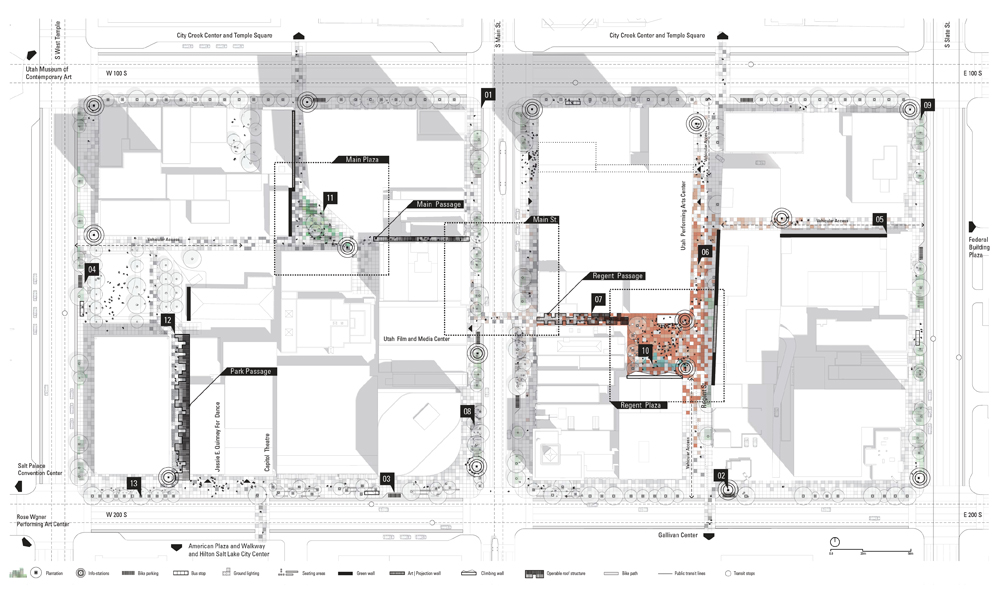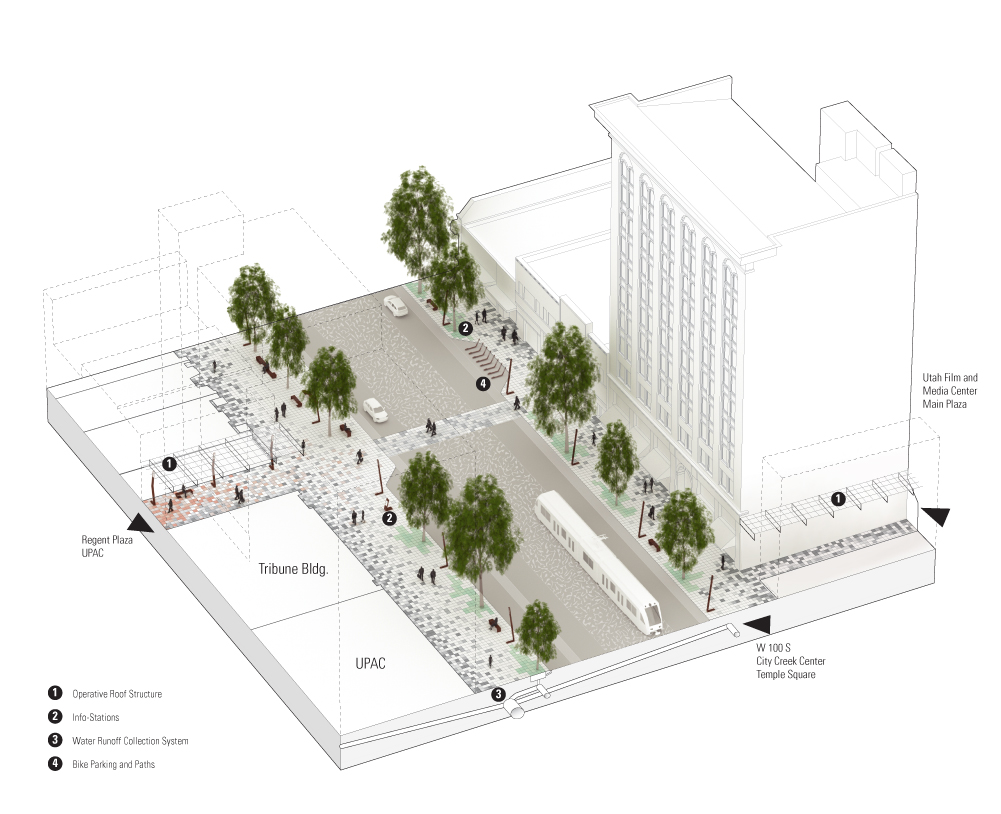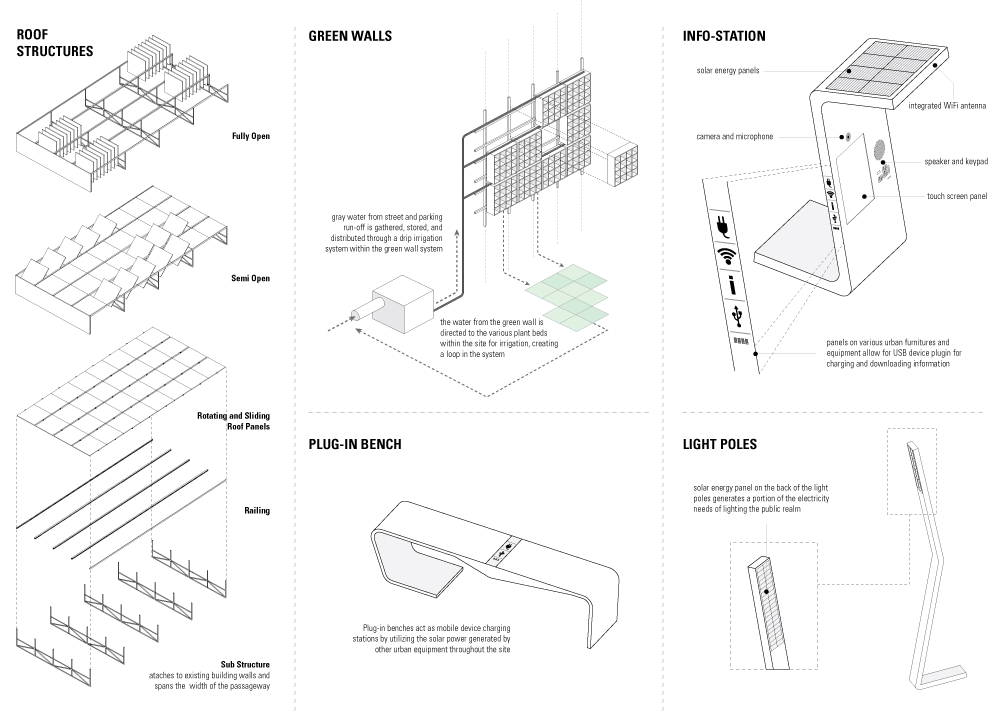6970+
Public Realm Design for Two Urban Blocks
Salt Lake City | 2013
Design Team: Ali Fard & Ghazal Jafari
Salt Lake City's growth and development is closely tied to its mining and industrial past, from the early days of the gold rush and mining activity to its current status as the largest industrial banking center in the United States. However, the city has tried in recent years to diversify its economic base to include service and tourism industries, as well as the creative sector. In doing so, various development projects have taken on the task of revitalizing the downtown and establishing SLC as not only a business center but also a cultural nucleus. With a growing downtown population, a thriving business community, and a vibrant new retail core, the city is in many ways experiencing a renaissance. The SixtyNine Seventy project presents an opportunity to unite the growing business/retail center and the enduring historic core of the city with an active cultural and creative nucleus that will enhance the metropolitan aspirations of the city.
![Site Plan]() 6970+
6970+
This project proposes a connective and activated public realm for the two blocks of Sixty Nine and Seventy. The site, as it currently stands, is dominated by office buildings, surface parking, and garages, which tend to engulf the more historic and cultural buildings of the area. While there are a number of formal connections to and from various parts of the site, a series of informal connection have also been created based on ease of movement and access, possessing an embedded intelligence which needs to be considered when proposing new connections. 6970+ proposes three main strategies:
1) Connectivity
A new ground cover strategy visually stitches together the various circulation spaces into a cohesive and easily recognizable movement surface. In addition, the various informal paths and trajectories that exist within the site are formalized into safe, well-lit spaces for circulation.As a result, a major East-West trajectory emerges which connects the various cultural programs within the site together. This mid-block cultural corridor is regularly intersected by North-South connections, hence creating a porous system of urban circulation that not only connects the various disparate cultural buildings within the site, but also connects the site to its larger context.
![Various layers of intervention + programmatic activation strategies]()
In addition to the physical connectivity infrastructure, a new digital information system is introduced, creating a larger connection between the activities of the site, the city, and even the global flows of information. Info-Stations are placed in strategic locations at intersections, major public spaces, and along the cultural corridor,to provide WiFi hotspots as well as information regarding the events within the 69-70 site, ticketing services for these events, city-wide navigation maps, and interactive public transportation schedules. These info-stations and other urban equipment within the site (for seating, lighting, etc.) also provide mobile device charging capabilities through integrated solar panel energy generation.Together, the digital information system and the physical circulation spaces constitute a connective urban fabric that produces and reinforces internal and external connections.
![Regent Plaza]() 2) Activation of open and residual spaces
2) Activation of open and residual spaces
The 69-70 site features a large number of residual and undefined open spaces dominated by surface parking. 6970+stimulates the site by transforming these left-over areas into an active network of public spaces, which we call the cultural corridor. Optimizing the existing parking garages within the area minimizes surface parking, and the facades of parking garages are transformed into active surfaces by introducing green walls, media screens, art walls, and rock climbing walls. In addition,a main public plaza is introduced in each block. The Regent Plaza (inspired in part by the current plans for the UPAC complex and the goal of transforming Regent St. into a retail corridor) is programmed as an open cultural space. Reflecting the cultural programming around the area, Regent Plaza can be used as an event space for film screenings (by utilizing the western wall of the parking garage on Regent St), outdoor concerts in the summer, and ice skating in winter.The Main Plaza is carved out of the back of the future building expected at the corner of 100 and Main streets, and creates a mid-block open space for small gatherings, weekend markets, or just a nice place to have lunch on a workday.
![Main Plaza]()
In addition, a series of mid-block passageways are introduced as semi-open and seasonal spaces, which can be programmed through a variety of cultural activities such as art shows, presentations, and other public gatherings. While their main task is circulation, these passages are imagined as pockets that can also be programmed.
![Main Street, showing connections to mid-block passages]()
3) Extension of Use
It is important to take into consideration the climatic conditions of SLC when designing open spaces in the city. Hence, the public realm envisioned for the 69-70 site makes use of various heating and cooling strategies to facilitate outdoor programming throughout the year. Heating is provided through in-ground steam valves that generate steam from the run-off water and melting snow to warm up smaller urban pockets, such as Main Plaza in the winter months, while mist poles create a playful cooling effect in Regent Plaza in the summer. In effect, these microclimates extend the use of public spaces seasonally. Given the nature of the 69-70 site, and the cultural, entertainment, and dining oriented activities of the area, it is important to implement a strategy for the night-time activation of the site. In 6970+ this is done through a lighting strategy that creates a set of lively circulation spaces, as well as guiding the pedestrian traffic to specific locations of the site through in-ground lighting techniques.
![View of Regent Plaza in the summer]() The Active Surface
The Active Surface
The three main strategies mentioned above are implemented through an Active Surface. Imagined as a container that facilitates a variety of temporal activities and events throughout the year, the Active Surface is defined by its spatial flexibility and operational diversity.As a concept, the Active Surface is imagined as a pixelated surface in which each pixel is programmable and responds to a local condition, be it climatic, programmatic or interactive. Pixels are easily interchangeable and create a dynamic and flexible structure for (re)organizing the site and its various design elements. The interaction among pixels generates a whole, which is greater than the sum of its parts by responding not only to specific local conditions but also to larger contextual issues of place making and ecological sensitivity.
In practice, the property of each pixel has been defined by introducing a set of variables. These variables include material properties (hard surface or vegetation) as well as operational and geometrical properties. The pixelation, therefore, transforms from a flat condition to three-dimensional form to incorporate a variety of urban equipments, some with singular uses, such as seating and lighting, and some with more complex operational capacities, such as structural support or micro-climate generation.
![]()
Material Strategy
The industrial history of Utah and SLC and their relationship to mining and stone quarries is reflected through the materiality of 6970+. The materials used in the design of 6970+ can be sourced locally from within Utah. The multicolored paving stones of the Active Surface (Limestone, Sandstone and Granite of various shades) are quarried within Utah, while the Corten cladding of the various urban equipment will be sourced from the iron mines of Utah and manufactured within the state. In addition, a new digital layer is added to this materiality through the integration of various information and communication technologies in the design of the urban equipment. The information provided through this digital platform will communicate the events and happenings of the 69-70 site, and will be produced with the help of SLC's creative firms. Coupled with renewable energy generation and reuse and recycling strategies for the runoff water collected from the site, this virtual materiality adds a new layer of intelligence to the material composition of 6970+. In essence, the materiality of 6970+ is imbued with the historical trajectory of SLC and its future as the creative core of Utah and a world-class city.
![View of Main Plaza in winter]()

This project proposes a connective and activated public realm for the two blocks of Sixty Nine and Seventy. The site, as it currently stands, is dominated by office buildings, surface parking, and garages, which tend to engulf the more historic and cultural buildings of the area. While there are a number of formal connections to and from various parts of the site, a series of informal connection have also been created based on ease of movement and access, possessing an embedded intelligence which needs to be considered when proposing new connections. 6970+ proposes three main strategies:
1) Connectivity
A new ground cover strategy visually stitches together the various circulation spaces into a cohesive and easily recognizable movement surface. In addition, the various informal paths and trajectories that exist within the site are formalized into safe, well-lit spaces for circulation.As a result, a major East-West trajectory emerges which connects the various cultural programs within the site together. This mid-block cultural corridor is regularly intersected by North-South connections, hence creating a porous system of urban circulation that not only connects the various disparate cultural buildings within the site, but also connects the site to its larger context.

In addition to the physical connectivity infrastructure, a new digital information system is introduced, creating a larger connection between the activities of the site, the city, and even the global flows of information. Info-Stations are placed in strategic locations at intersections, major public spaces, and along the cultural corridor,to provide WiFi hotspots as well as information regarding the events within the 69-70 site, ticketing services for these events, city-wide navigation maps, and interactive public transportation schedules. These info-stations and other urban equipment within the site (for seating, lighting, etc.) also provide mobile device charging capabilities through integrated solar panel energy generation.Together, the digital information system and the physical circulation spaces constitute a connective urban fabric that produces and reinforces internal and external connections.

The 69-70 site features a large number of residual and undefined open spaces dominated by surface parking. 6970+stimulates the site by transforming these left-over areas into an active network of public spaces, which we call the cultural corridor. Optimizing the existing parking garages within the area minimizes surface parking, and the facades of parking garages are transformed into active surfaces by introducing green walls, media screens, art walls, and rock climbing walls. In addition,a main public plaza is introduced in each block. The Regent Plaza (inspired in part by the current plans for the UPAC complex and the goal of transforming Regent St. into a retail corridor) is programmed as an open cultural space. Reflecting the cultural programming around the area, Regent Plaza can be used as an event space for film screenings (by utilizing the western wall of the parking garage on Regent St), outdoor concerts in the summer, and ice skating in winter.The Main Plaza is carved out of the back of the future building expected at the corner of 100 and Main streets, and creates a mid-block open space for small gatherings, weekend markets, or just a nice place to have lunch on a workday.

In addition, a series of mid-block passageways are introduced as semi-open and seasonal spaces, which can be programmed through a variety of cultural activities such as art shows, presentations, and other public gatherings. While their main task is circulation, these passages are imagined as pockets that can also be programmed.

3) Extension of Use
It is important to take into consideration the climatic conditions of SLC when designing open spaces in the city. Hence, the public realm envisioned for the 69-70 site makes use of various heating and cooling strategies to facilitate outdoor programming throughout the year. Heating is provided through in-ground steam valves that generate steam from the run-off water and melting snow to warm up smaller urban pockets, such as Main Plaza in the winter months, while mist poles create a playful cooling effect in Regent Plaza in the summer. In effect, these microclimates extend the use of public spaces seasonally. Given the nature of the 69-70 site, and the cultural, entertainment, and dining oriented activities of the area, it is important to implement a strategy for the night-time activation of the site. In 6970+ this is done through a lighting strategy that creates a set of lively circulation spaces, as well as guiding the pedestrian traffic to specific locations of the site through in-ground lighting techniques.

The three main strategies mentioned above are implemented through an Active Surface. Imagined as a container that facilitates a variety of temporal activities and events throughout the year, the Active Surface is defined by its spatial flexibility and operational diversity.As a concept, the Active Surface is imagined as a pixelated surface in which each pixel is programmable and responds to a local condition, be it climatic, programmatic or interactive. Pixels are easily interchangeable and create a dynamic and flexible structure for (re)organizing the site and its various design elements. The interaction among pixels generates a whole, which is greater than the sum of its parts by responding not only to specific local conditions but also to larger contextual issues of place making and ecological sensitivity.
In practice, the property of each pixel has been defined by introducing a set of variables. These variables include material properties (hard surface or vegetation) as well as operational and geometrical properties. The pixelation, therefore, transforms from a flat condition to three-dimensional form to incorporate a variety of urban equipments, some with singular uses, such as seating and lighting, and some with more complex operational capacities, such as structural support or micro-climate generation.

Material Strategy
The industrial history of Utah and SLC and their relationship to mining and stone quarries is reflected through the materiality of 6970+. The materials used in the design of 6970+ can be sourced locally from within Utah. The multicolored paving stones of the Active Surface (Limestone, Sandstone and Granite of various shades) are quarried within Utah, while the Corten cladding of the various urban equipment will be sourced from the iron mines of Utah and manufactured within the state. In addition, a new digital layer is added to this materiality through the integration of various information and communication technologies in the design of the urban equipment. The information provided through this digital platform will communicate the events and happenings of the 69-70 site, and will be produced with the help of SLC's creative firms. Coupled with renewable energy generation and reuse and recycling strategies for the runoff water collected from the site, this virtual materiality adds a new layer of intelligence to the material composition of 6970+. In essence, the materiality of 6970+ is imbued with the historical trajectory of SLC and its future as the creative core of Utah and a world-class city.
